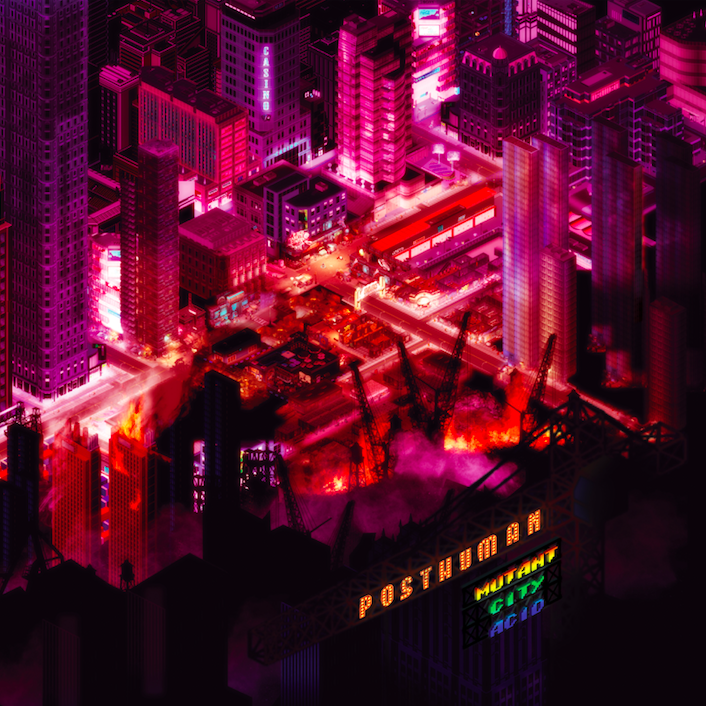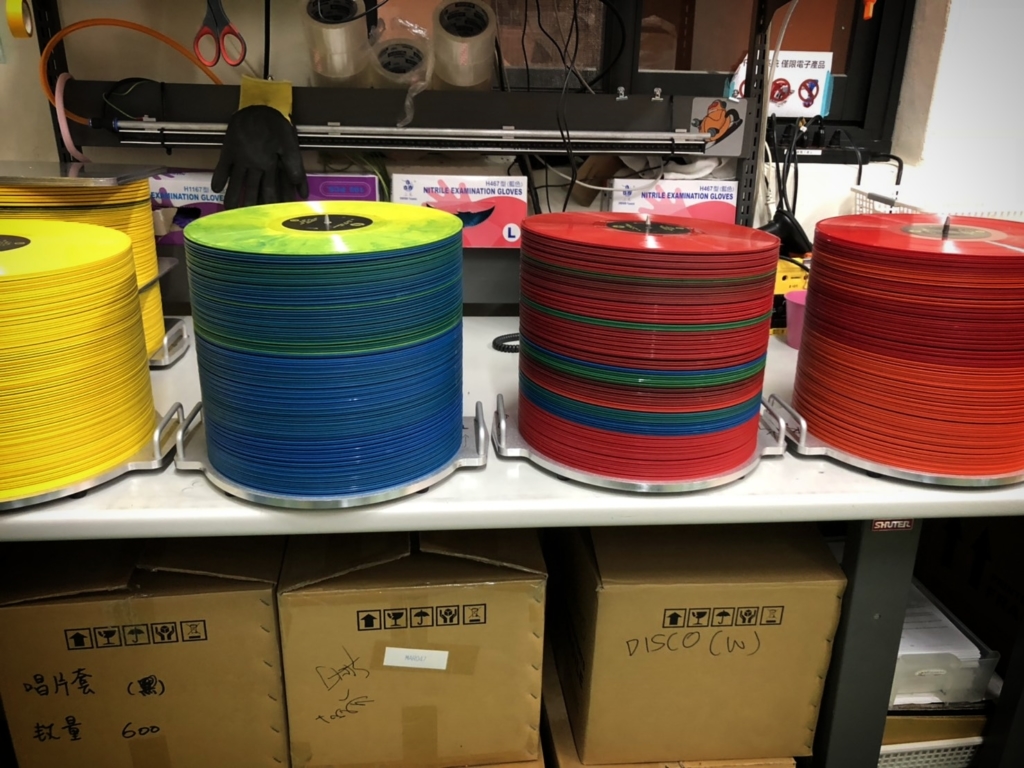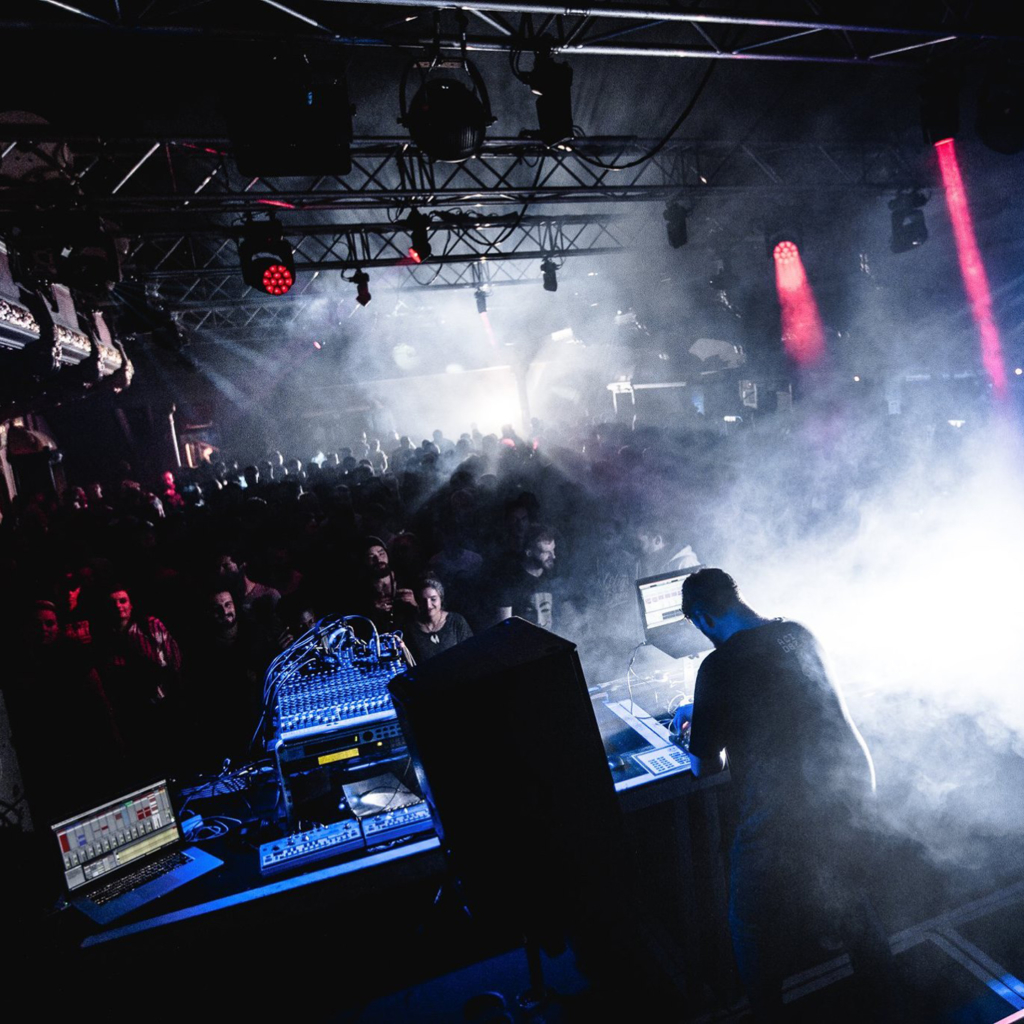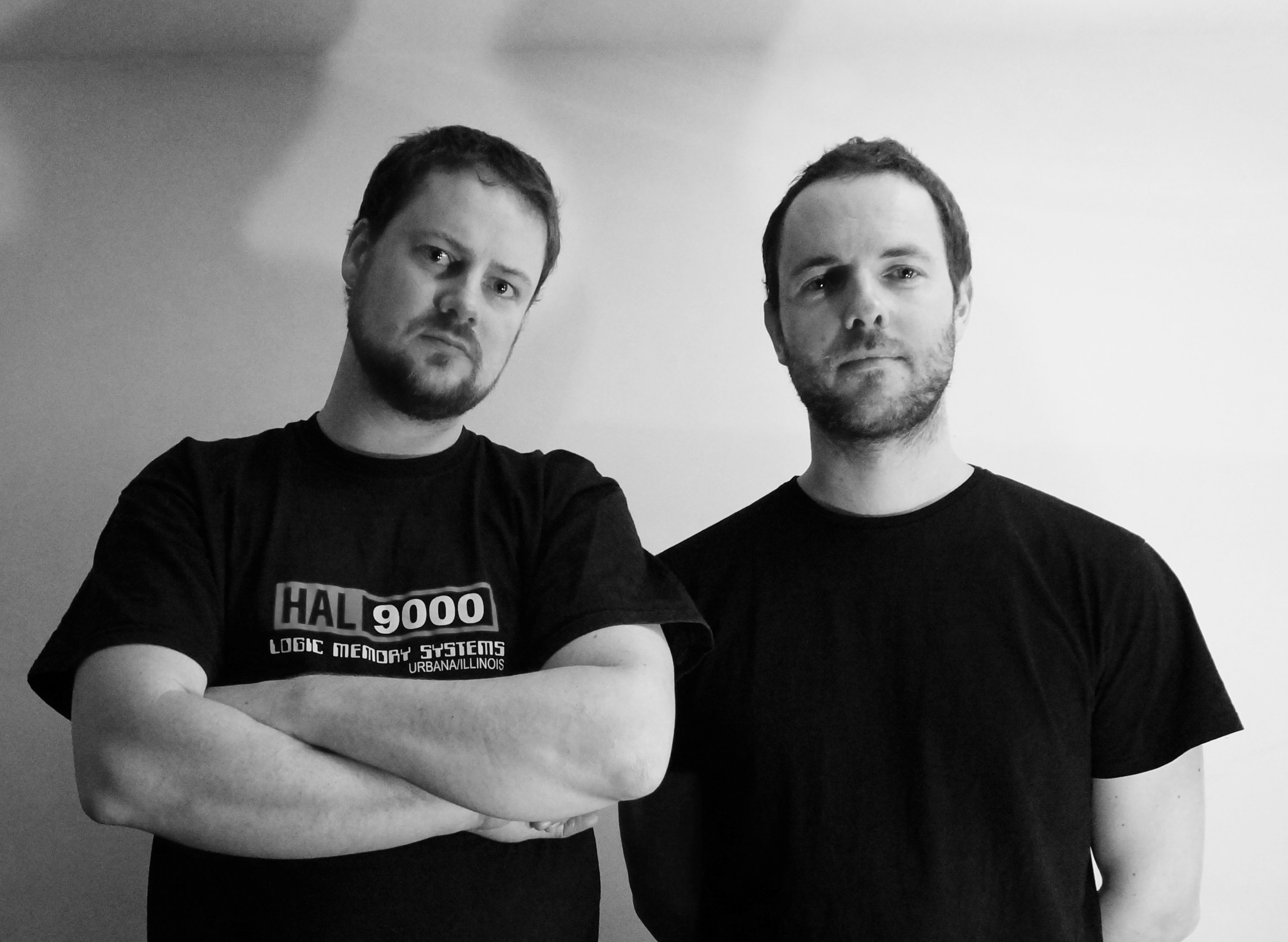You could say that Posthuman have become acid veterans over the years, having been in action since the late 90’s. A duo formed of cousins Rich Bevan and Josh Doherty, they are part of the a group of artists who are leading the way for the UK Acid House Revival with their decade spanning I Love Acid parties and two record labels I Love Acid and Balkan Vinyl. The imprints have become a home for tastemakers such as Luke Vibert, Mark Archer, Snuff Crew, Jerome Hill and Cardopusher whilst the parties have booked the likes of DMX Krew, Carl Finlow, Nightwave, DJ Boring and Luca Lozano. Both platforms are a hot bed for fresh and exciting new music, looking at the future rather than what the scene once was. The next party will be held at Five Miles, London this Friday.
Aside from their labels and parties, Posthuman have released on Tusk Wax, Dixon Avenue Basement Jams, Chiwax and Body Work and now return to their Balkan Vinyl imprint for their first album in 8 years ‘Mutant City Acid’. In the press release, it states that the album is “journey into and through a nightmarish urban sprawl, under the glow of neon skyscrapers in a dystopian near-future. Inspired by the sounds and design of late 80’s and early 90’s sci-fi computer games and based as a companion piece to the Mutant City Acid various artist 12″ series on Balkan.” To emphasis this colourful world Posthuman have imagined, the album is being pressed on multi-coloured vinyl as well as an accompanying ambient version on cassette. We caught up with the duo to discuss the album, why the long break between the LPs, the decision to run limited edition vinyl on I Love Acid, how they continue to stay excited about music and what they would like to explore next.
‘Mutant City Acid’ is your first album in 8 years, why the long hiatus?
Plans for the album actually started about just over 3 years ago. Rich and I had a recording session that resulted in “Nightride to New Reno” and “The Damocles Syndicate” which we immediately put aside as album tracks and started talking about the concept. The first Mutant City Acid various artists 12″ had come out on my label and number two was ready and about to drop, Rich loved the pixel art retro-futurist computer game graphics and said that was the direction we should go in. Damocles ended up being given to Shipwrec Records earlier this year but I do feel it kinda of part of the album. But then we both started families – our sons were born 10 weeks apart in summer 2016, so everything started taking a LOT longer to do, as I’m sure anyone with kids will understand! We had the graphics and concept ready about a year ago and it’s taken til now to complete the last few bits of the tracks and get it all together coherently.

What is your approach to the album format? Do you tend to come up with a concept first or decide during the production process?
With this one, it came from those first two tracks, then took inspiration from the vinyl series already on my label. Conversations and ideas kept building up backwards and forwards that turned into the tube map, the little notes about city districts, and the concept of doing an ambient version that was more a soundtrack to the city. Every time one of us would read a book or see a movie that inspired us, we’d email the other and slowly but surely all the parts came together.
In the press release it says the album is inspired by the sounds and designs of late 80s and early 90s sci-fi computer games, why this era? What draws you to the design of computer games?
There’s a fantastic kind of punk grittiness to classic pixel art from games of that era, and the strange juxtaposition of feeling both retro and futuristic. But it’s also things from the real world like Kowloon City and the street night markets of Bangkok that inspire. The atmosphere of games like Flashback, Beneath a Steel Sky, and The Dig and the worlds they conjure is strangely difficult to recreate with modern graphics, things almost feel too polished. I guess it’s the same as why using old drum machines has something more about it than lovely new plugins…
How do you manipulate visuals into sounds? Does this process come quite naturally to you both?
Much more for Rich than me. He has synesthesia, so his approach obviously weighs in that direction. Our last album was built around the video from his final project at university (for his second degree, in architecture – first time round he did politics)
I’m very much the opposite style, I’m a bodge-jobber – I use crappy old software and never read the manual for anything, spend my time ripping youtube videos and sticking them together. You can see the distinct difference easily!
What does your dystopian near-future look like?
Frighteningly similar to current reality. Brexit. Trump. Amazon. Dubai.
Futurism is a topic that is explored a lot within electronic music, what does that term mean to you?
I guess science fiction and futurism gives you a palette to explore themes and ideas through metaphor. Everything we do is about the future, in a way – it’s the driving mechanism behind humanity, for better or worse. Because electronic music is literally, using new machines to create and organise sound, and giving options to try new ideas and combinations that were perhaps limited by more conventional instruments, naturally futurism would always been a central theme to electronic music. Just think about the explosion of new things you could do once the guitar was electrified and amplified. Apply that exponentially with computers and synthesisers.
The album will be pressed on double coloured 12” in a variety of different colours, what inspired this unique approach to vinyl pressing?
I’d been having a frustrating time with records the last couple of years, insane delays (sometimes over 6 months) and repeated poor quality pressings, warped vinyl. A broker I’ve worked with for years themselves was also feeling the same way from their side, so they decided to buy a brand new Warmtone and start pressing themselves. I’d always liked working with them because they were just more honest and transparent than anyone else I’d dealt with, so once their press was up and running I immediately moved all my records to them.
I got chatting with my contact there about coloured vinyl and asked what would happen if you started changing the wax style throughout the press. They’d not tried it before – I’d never seen it before either (though I have been since informed there is another multicolour wax out there, but I checked it out, and the sound quality on it is awful) so we went ahead with it as an experiment.
There were a few restrictions – keeping the same PVC base so as to not have different melting points (and as a result, low quality wax) which meant one record is a variety of solid colours, the other a variety of translucents. There were a few varying results – sometimes the changes between colours would marble, other times it would be more speckled, or just smoky…a few times the colours simply mixed and change the base colour – in one instance it simply slowly faded from red to orange with very little marbling or streaking. The only issue is, it took about twice as long as normal, so the plant have said they won’t do it again!

You run a limited edition vinyl-series called I Love Acid, what made you decide to do a vinyl-only imprint? There’s been a lot of discussion on Twitter lately talking about the exclusivity of vinyl-only releases with the word ‘elitism’ thrown around.
From the very start, the idea was a vinyl-only run of 303 copies, no represses. I discussed the idea with the artists and they were up for it. No-one minded at first, but then once they started becoming popular and selling out quickly, the complains began to pour in.
We live in an age of entitlement. We think simply because something exists, we have the right to it in our preferred format. I get angry emails every time a record sells out “You should make this available digitally, music is universal, you are an elitists snob!” etc. – yet rarely do these emails come from the same people who ever buy any of the digital-only releases on the label.
My argument is – if a painter decided they were only going to sell their work as framed and signed limited edition of high-quality prints, would you email abuse to the gallery demanding they make it available as a .jpg for your iPhone wallpaper? It’s an artists prerogative to release their work however and wherever they please. If that’s a single reel-to-real buried in the desert with only a cryptic map to find it, then so be it. If you don’t like what I do, it’s not like there’s no other music in the world.
The irony of this is I am a digital DJ myself. And if there’s a vinyl-only release that I can’t get hold of, well then – I don’t get to play it out. I might be disappointed but I’d never complain! Besides, tracking down things is all part of the magic. And of course, as with anything limited and in demand, there will be some who buy simply to sell on at increased prices: but if you look at the ACTUAL sales numbers of discogs scalpers, not that many really sell for crazy prices anyway.
How do you choose which release is suitable for a limited run on I Love Acid or Balkan?
Honestly, they just have a different feel and I can tell in my bones. I know that sounds pretentious but it’s how it is!
I’ve stopped taking unsolicited demos these days, I prefer to approach artists directly myself and ask for music. I feel this is the way to get the work that fits my labels. Also I’ve learnt that it’s kinda important to build up a rapport and check the artist isn’t a twat before locking in a deal with them. Personality is important!

The I Love Acid parties have been running for 11 years now – after all these years what keeps these parties exciting to you? What’s the most enjoyable part of bringing your concept to a club setting?
It’s still exciting because it’s not a retrospective thing. There are a lot of acid nights that are all about being throwbacks, same DJs playing the same big tracks, to the same crowd – everthing weighed down with the expectation and comparisons to an imagined perfect nostalgic time. You can’t capture the feeling of something being new unless you ACTUALLY play new music. This is why my radio show is dedicated to only playing new acid.
My favourite thing is seeing people discover something new. The crowds at I Love Acid are really mixed and diverse, different age groups, different scenes. Seeing someone lose their shit to a brand new track, never gets boring.
What are some of your favourite memories from I Love Acid parties?
Final Frontier being dropped as the very last track at our very last night at Ginglik. It’d been our home for 7 years, every month – and that track is the unofficial anthem of I Love Acid.
Perseus Traxx spinning Andreas Gehm’s Heaven & Hell in Leeds a couple years ago, it was the first time I’d heard it played after he passed away. Was a real special moment.
Playing Damocles Syndicate out, in full, at then end of my set Hidden in Manchester last year to an entirely enraptured crowd was incredible. I was shaking all over. It has such a long, weird breakdown in the middle that it’s impossible to play and keep a crowd onside unless you absolutely have them in the palm of your hand, a difficult thing to pull off.
Absolutely losing it while Jon Dasilva was playing, dancing in the booth at Moog Club in Barcelona for one of our 10th Birthday bashes, the barstaff had been feeding me free tequilas all night and I’d gotten rather carried away.
Arts School Union venue in Glasgow, with the Something Wicked crew. I met my wife there at my first gig there 15 years ago, have played a few times since but to finally do an I Love Acid there really meant a lot.
How do you feel the clubbing landscape has changed over the years?
The stigma of age groups has vanished. No one gives a shit if your 18 or 58 if you’re having it on the dancefloor. I think this is down to two things – firstly, this music has been around long enough to have fans from all demographics, and secondly – social media means we link up with people of similar interests, rather than just those the same age from the same locations, or workplaces.
But also, crowds are more demanding, sometimes to a detriment of new artists or ideas. They know what they want, and it’s big names playing expected styles. Big corporate sponsored events where the lineup all have the same management company, and punters are buying £50 VIP tickets…this shit is the opposite of what the rave scene was about.
This isn’t always the case though, there are fantastic events like The Acid Experiment in Birmingham who have a really open approach to genre, and don’t play the obvious high-profile DJ game – and their crowds respond in like. One of the best events in the country, and I hope that approach will start taking more elsewhere.
Having been in the industry for two decades, what do you hope to achieve next? Are there any other creative formats you are looking to explore that you haven’t done yet?
I’d like to do more video, and properly interactive A/V sets. I love the idea of assigning different visual elements to specific sounds and effects, so what you see is an exact visual rendering of what you hear. But I don’t have the time or skills to pull that off right now, haha. Maybe one day.
There are a lot of lost arts of vinyl, locked grooves, reverse pressing, multiple grooves etc. I’m hoping with all the new plants coming on line that those techniques will be rediscovered and we can start having a little more fun with records.
Right now I’m just enjoying DJing and gigging out in new places. I’ve been doing this a long time, but in the last couple of years that side of things has exploded. This year I’ve played shows 45 out of 52 weekends, either as Posthuman or part of Altern 8, last year was similar. And I love it still as much as ever.
‘Mutant City Acid’ by Posthuman is out now via Balkan Vinyl – buy here and I Love Acid x Five Miles tickets here.
